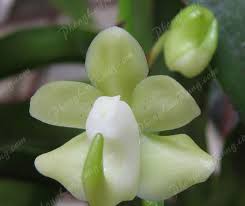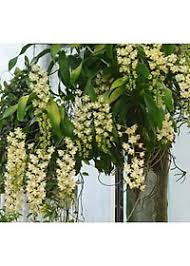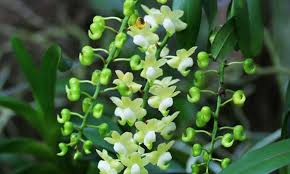
Quế Lan Hương, known as the fragrant orchid or Dendrobium anosmum, is not only cherished for its captivating beauty and enchanting aroma but also holds a special place in the hearts of many artists, poets, and writers, especially in Vietnamese culture. Its significance transcends mere aesthetics, weaving itself into the very fabric of literature and art, where it symbolizes beauty, love, and the profound connection between humans and nature. This article delves into the rich literary and artistic representations of Quế Lan Hương, exploring its cultural impact and the emotions it evokes through various creative expressions.
## 1. The Essence of Quế Lan Hương
### A. Botanical Characteristics
Quế Lan Hương is a tropical orchid native to Southeast Asia, particularly Vietnam, Thailand, and the Philippines. Characterized by its long, slender stems and clusters of fragrant flowers, the orchid showcases a palette of colors ranging from purple to white and yellow. Blooming in spring, Quế Lan Hương is often associated with renewal and rebirth, making it a popular choice for various celebrations, including Tet, the Lunar New Year.
### B. Cultural Significance
In Vietnamese culture, Quế Lan Hương is more than just a flower; it embodies ideals of purity, grace, and loyalty. Its fragrant blooms are often used in traditional ceremonies, symbolizing hope and prosperity. The beauty and fragrance of the orchid have inspired countless stories, poems, and artworks, reflecting the deep connection between nature and human emotion.
## 2. Quế Lan Hương in Vietnamese Poetry
### A. Celebrating Nature’s Beauty
Poets have long used Quế Lan Hương as a muse, celebrating its beauty and fragrance in verses that capture the essence of nature. The orchid serves as a metaphor for purity and the fleeting nature of life, inviting reflection on the passage of time and the ephemeral moments of beauty.
For instance, a poem might evoke the image of the orchid blooming in the spring, its fragrance wafting through the air, inviting readers to pause and appreciate the beauty of the present moment. This connection to nature often serves as a backdrop for deeper themes of love, loss, and longing.
### B. Thematic Interpretations
In Vietnamese poetry, Quế Lan Hương frequently symbolizes the complexity of human emotions. Its delicate beauty represents love’s fragility, while its intoxicating scent evokes memories and nostalgia. Poets often juxtapose the orchid’s beauty with themes of separation or longing, creating a poignant contrast that resonates with readers.
For example, a poet may use the image of Quế Lan Hương to express feelings of yearning for a lost love, illustrating how the fragrance of the flower can evoke vivid memories of moments shared together. This interplay between the natural world and human emotion highlights the profound impact that nature has on our lives and experiences.
### C. Notable Poets and Works
Several renowned Vietnamese poets have drawn inspiration from Quế Lan Hương, incorporating it into their works. For instance:
– **Xuân Diệu**: Known for his romantic poetry, Xuân Diệu often celebrates nature’s beauty, including orchids, to express love and longing. His verses capture the fleeting moments of beauty, much like the blooms of Quế Lan Hương.
– **Huy Cận**: In his poems, Huy Cận reflects on the beauty of nature and the passage of time, often using flowers, including Quế Lan Hương, as symbols of transience and memory.
These poets, among others, have immortalized Quế Lan Hương in their verses, creating a rich tapestry of emotions that resonate with readers across generations.
## 3. Quế Lan Hương in Vietnamese Literature
### A. Folktales and Legends
Quế Lan Hương is often featured in Vietnamese folktales and legends, where its beauty and fragrance are intertwined with stories of love, sacrifice, and devotion. These tales not only celebrate the orchid but also impart moral lessons and cultural values.
#### The Tale of the Fragrant Maiden
One popular folktale tells the story of a beautiful maiden named Lan, whose fragrance was so enchanting that it could captivate anyone who encountered her. One day, while wandering in the forest, she discovered the rare orchid and wished for it to flourish. In gratitude, the orchid bloomed abundantly, spreading joy throughout the village. This story exemplifies the deep connection between Quế Lan Hương and themes of love, beauty, and harmony with nature.
### B. Symbolism in Literature
In Vietnamese literature, Quế Lan Hương often symbolizes the delicate balance between beauty and fragility. Authors and playwrights use the orchid as a metaphor for characters’ emotional journeys, illustrating how beauty can inspire hope, love, and longing while also serving as a reminder of life’s transience.
– **Character Development**: Writers may depict characters who embody the qualities of Quế Lan Hương—graceful, resilient, and yet vulnerable—using the orchid to reflect their growth and struggles throughout the narrative.
– **Cultural Identity**: The presence of Quế Lan Hương in literature serves as a testament to Vietnamese cultural identity, reinforcing the importance of nature and its connection to human experiences.
## 4. Quế Lan Hương in Visual Arts
### A. Artistic Representations
Quế Lan Hương has inspired countless artists, who depict its beauty in various forms of visual art. From traditional paintings to modern sculptures, the orchid’s delicate petals and vibrant colors serve as a source of inspiration for artistic expression.
#### Traditional Vietnamese Painting
In traditional Vietnamese painting, Quế Lan Hương is often featured in landscape scenes or floral arrangements, highlighting its aesthetic beauty. Artists skillfully capture the orchid’s elegance, using delicate brushstrokes and vibrant colors to evoke the flower’s fragrance and grace.
– **Lý Nguyên**: A prominent artist known for his depictions of flowers, Lý Nguyên often incorporates Quế Lan Hương into his work, celebrating its beauty and cultural significance.
– **Bùi Xuân Phái**: This artist is known for his mastery of color and light, often depicting floral arrangements, including Quế Lan Hương, that evoke a sense of tranquility and harmony.
### B. Contemporary Art
In contemporary art, Quế Lan Hương continues to inspire new interpretations. Artists explore the orchid’s beauty through various mediums, including photography, sculpture, and mixed media.
– **Photography**: Photographers capture the intricate details of Quế Lan Hương, showcasing its vibrant colors and delicate structure. These images often evoke a sense of wonder and appreciation for nature’s artistry.
– **Sculpture**: Sculptors create intricate representations of the orchid, exploring its form and texture while emphasizing its cultural significance. These sculptures serve as a testament to the orchid’s beauty and its place in Vietnamese culture.
### C. Quế Lan Hương in Performance Art
In addition to visual arts, Quế Lan Hương has made its way into performance art. Dancers and choreographers often draw inspiration from the orchid’s grace, incorporating its movements into their performances.
– **Traditional Dance**: Traditional Vietnamese dance often features elements inspired by nature, including the elegance of flowers like Quế Lan Hương. Dancers may embody the fluidity and grace of the orchid through their movements, creating a harmonious connection between art and nature.
– **Modern Interpretations**: Contemporary dance performances may explore themes of love and longing using the orchid as a central motif, illustrating how the flower’s beauty can evoke powerful emotions.
## 5. The Role of Quế Lan Hương in Cultural Events
### A. Tet Celebrations
Quế Lan Hương plays a significant role in Vietnamese cultural events, particularly during Tet, the Lunar New Year. During this festive season, families decorate their homes with various flowers, and Quế Lan Hương is a popular choice due to its beauty and fragrant blooms.
#### Symbol of Prosperity
Families believe that displaying Quế Lan Hương during Tet brings good luck and prosperity for the coming year. The orchid is often placed on altars and in homes, symbolizing gratitude for the past year and hope for the future. This tradition reflects the deep cultural significance of the flower, highlighting its role in fostering family bonds and cultural heritage.
### B. Cultural Festivals
Throughout the year, Quế Lan Hương is celebrated in various cultural festivals across Vietnam. These events often showcase traditional music, dance, and art, with the orchid serving as a central theme.
– **Floral Festivals**: Many cities host floral festivals where artists and gardeners come together to celebrate the beauty of flowers, including Quế Lan Hương. These events feature floral displays, competitions, and workshops, fostering a sense of community and appreciation for nature.
– **Cultural Exhibitions**: Cultural exhibitions often highlight the significance of Quế Lan Hương in Vietnamese art and literature. These exhibitions may include artworks, poetry readings, and performances that celebrate the orchid’s beauty and cultural impact.
## 6. The Preservation of Quế Lan Hương’s Cultural Legacy
### A. Conservation Efforts
As urbanization and environmental changes threaten the natural habitats of Quế Lan Hương, conservation efforts are increasingly vital. Organizations and individuals are working to protect the orchid’s native habitats and promote sustainable practices.
#### Educating the Public
Educating the public about the importance of preserving Quế Lan Hương and its habitat is essential for fostering appreciation and care for this cultural treasure. Workshops, seminars, and community programs can raise awareness about the orchid’s significance in Vietnamese culture and its role in supporting biodiversity.
### B. Engaging Communities
Community involvement is crucial for conservation efforts. Local communities can participate in programs aimed at protecting the environment and promoting sustainable practices. By engaging in these efforts, communities can help ensure the survival of Quế Lan Hương and the rich cultural heritage associated with it.
### C. Collaborating with Artists
Collaborating with artists and
poets can amplify conservation messages. By incorporating themes of Quế Lan Hương into their work, artists can inspire others to appreciate and protect the orchid and its habitat, creating a cultural movement centered around conservation.
## Conclusion
Quế Lan Hương is more than just a beautiful flower; it is a symbol of love, beauty, and cultural identity in Vietnam. Its presence in literature and art enriches the cultural landscape, inspiring poets, artists, and communities to celebrate its beauty and significance. Through various forms of creative expression, Quế Lan Hương continues to captivate hearts and minds, serving as a reminder of the profound connection between nature and human emotion.
As we honor the legacy of Quế Lan Hương in literature and art, it is essential to recognize the importance of conservation efforts to protect this treasured orchid and its habitat. By fostering appreciation and engaging communities, we can ensure that the fragrance of Quế Lan Hương continues to fill our lives for generations to come. Through art, literature, and cultural practices, we can celebrate and preserve the enduring beauty and significance of this remarkable flower.


